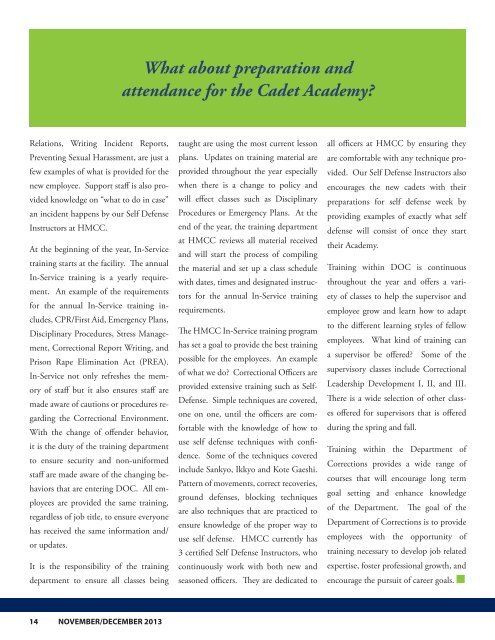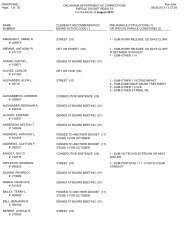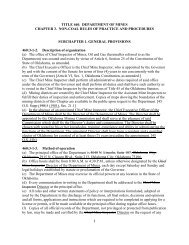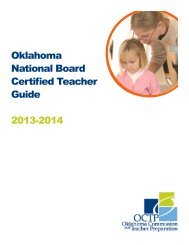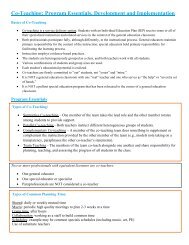Training and Staff Development - State of Oklahoma
Training and Staff Development - State of Oklahoma
Training and Staff Development - State of Oklahoma
Create successful ePaper yourself
Turn your PDF publications into a flip-book with our unique Google optimized e-Paper software.
What about preparation <strong>and</strong><br />
attendance for the Cadet Academy?<br />
Relations, Writing Incident Reports,<br />
Preventing Sexual Harassment, are just a<br />
few examples <strong>of</strong> what is provided for the<br />
new employee. Support staff is also provided<br />
knowledge on “what to do in case”<br />
an incident happens by our Self Defense<br />
Instructors at HMCC.<br />
At the beginning <strong>of</strong> the year, In-Service<br />
training starts at the facility. The annual<br />
In-Service training is a yearly requirement.<br />
An example <strong>of</strong> the requirements<br />
for the annual In-Service training includes,<br />
CPR/First Aid, Emergency Plans,<br />
Disciplinary Procedures, Stress Management,<br />
Correctional Report Writing, <strong>and</strong><br />
Prison Rape Elimination Act (PREA).<br />
In-Service not only refreshes the memory<br />
<strong>of</strong> staff but it also ensures staff are<br />
made aware <strong>of</strong> cautions or procedures regarding<br />
the Correctional Environment.<br />
With the change <strong>of</strong> <strong>of</strong>fender behavior,<br />
it is the duty <strong>of</strong> the training department<br />
to ensure security <strong>and</strong> non-uniformed<br />
staff are made aware <strong>of</strong> the changing behaviors<br />
that are entering DOC. All employees<br />
are provided the same training,<br />
regardless <strong>of</strong> job title, to ensure everyone<br />
has received the same information <strong>and</strong>/<br />
or updates.<br />
It is the responsibility <strong>of</strong> the training<br />
department to ensure all classes being<br />
taught are using the most current lesson<br />
plans. Updates on training material are<br />
provided throughout the year especially<br />
when there is a change to policy <strong>and</strong><br />
will effect classes such as Disciplinary<br />
Procedures or Emergency Plans. At the<br />
end <strong>of</strong> the year, the training department<br />
at HMCC reviews all material received<br />
<strong>and</strong> will start the process <strong>of</strong> compiling<br />
the material <strong>and</strong> set up a class schedule<br />
with dates, times <strong>and</strong> designated instructors<br />
for the annual In-Service training<br />
requirements.<br />
The HMCC In-Service training program<br />
has set a goal to provide the best training<br />
possible for the employees. An example<br />
<strong>of</strong> what we do? Correctional Officers are<br />
provided extensive training such as Self-<br />
Defense. Simple techniques are covered,<br />
one on one, until the <strong>of</strong>ficers are comfortable<br />
with the knowledge <strong>of</strong> how to<br />
use self defense techniques with confidence.<br />
Some <strong>of</strong> the techniques covered<br />
include Sankyo, Ikkyo <strong>and</strong> Kote Gaeshi.<br />
Pattern <strong>of</strong> movements, correct recoveries,<br />
ground defenses, blocking techniques<br />
are also techniques that are practiced to<br />
ensure knowledge <strong>of</strong> the proper way to<br />
use self defense. HMCC currently has<br />
3 certified Self Defense Instructors, who<br />
continuously work with both new <strong>and</strong><br />
seasoned <strong>of</strong>ficers. They are dedicated to<br />
all <strong>of</strong>ficers at HMCC by ensuring they<br />
are comfortable with any technique provided.<br />
Our Self Defense Instructors also<br />
encourages the new cadets with their<br />
preparations for self defense week by<br />
providing examples <strong>of</strong> exactly what self<br />
defense will consist <strong>of</strong> once they start<br />
their Academy.<br />
<strong>Training</strong> within DOC is continuous<br />
throughout the year <strong>and</strong> <strong>of</strong>fers a variety<br />
<strong>of</strong> classes to help the supervisor <strong>and</strong><br />
employee grow <strong>and</strong> learn how to adapt<br />
to the different learning styles <strong>of</strong> fellow<br />
employees. What kind <strong>of</strong> training can<br />
a supervisor be <strong>of</strong>fered? Some <strong>of</strong> the<br />
supervisory classes include Correctional<br />
Leadership <strong>Development</strong> I, II, <strong>and</strong> III.<br />
There is a wide selection <strong>of</strong> other classes<br />
<strong>of</strong>fered for supervisors that is <strong>of</strong>fered<br />
during the spring <strong>and</strong> fall.<br />
<strong>Training</strong> within the Department <strong>of</strong><br />
Corrections provides a wide range <strong>of</strong><br />
courses that will encourage long term<br />
goal setting <strong>and</strong> enhance knowledge<br />
<strong>of</strong> the Department. The goal <strong>of</strong> the<br />
Department <strong>of</strong> Corrections is to provide<br />
employees with the opportunity <strong>of</strong><br />
training necessary to develop job related<br />
expertise, foster pr<strong>of</strong>essional growth, <strong>and</strong><br />
encourage the pursuit <strong>of</strong> career goals.<br />
14 NOVEMBER/DECEMBER 2013


